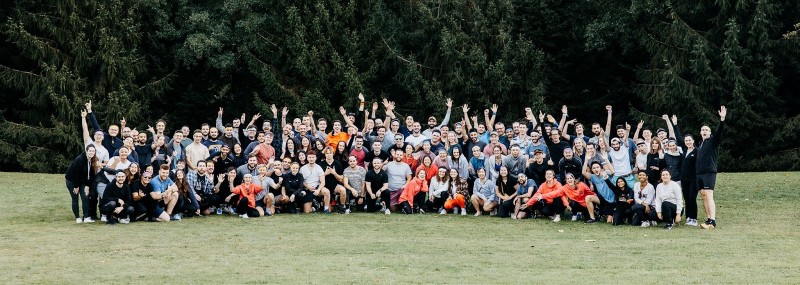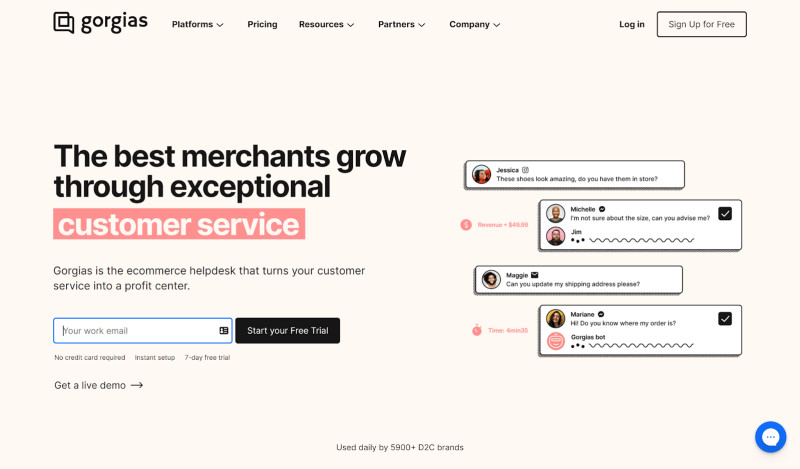How Gorgias Is Helping Thousands Of Shopify Businesses Turn Their Customer Supports Into Profit Centers
Gorgias is a startup that offers e-commerce businesses a platform to automate answers to the most common questions received from clients thanks to its machine learning algorithm. In an interview with The Org, entrepreneur and CEO Romain Lapeyre shared how the team went from persevering to find product-market fit to reaching a 200% yearly growth rate and building a client roaster of more than 7,200 merchants across the globe.

‘The Job Of A CEO Changes All The Time’
Today, the startup employs a 200-person team spread over three continents, including Australia, and that team is expected to grow to 250 employees by the end of the year. For Lapeyre, building a multicultural company, with no nationality being predominant, has been a priority since the very early days of the company. Affected by his experience working for a French startup based in San Francisco, where he found the duality between the American and the French cultures too strong to facilitate integration, the now-CEO carefully crafted the hiring process and the company culture to avoid this pitfall.
Diversity is reflected at every level of the company, including in leadership where five different nationalities are represented. At a macro level, the team’s structure relies on a multi-hub strategy with six offices where team members can meet two days a week, quarterly offsites as well as a yearly team gathering. Did the COVID-19 pandemic shake hiring plans? Not really. According to Lapeyre, the only effect the pandemic had was to accelerate the company’s existing effort in decentralization.
Asked about what he has learned about being a CEO, the 30-year-old founder answered: “The job of CEO changes all the time, basically every time the startup is moving to the next stage. In the beginning, when it’s just the founders, the job of the CEO is to find product-market fit, which requires a ’keep trying until it works’ mindset.”
From 1 to 10 employees, the CEO has to figure out how to sell the product more and how to make it a process. Lapeyre’s knowledge was built over reading, in particular Traction: How Any Startup Can Achieve Rapid Customer Growth by entrepreneurs Gabriel Weinberg and Justin Mares, as well as socializing. “I would spend a lot of time with other startup founders at the same growth stage to discuss challenges around a beer and a pizza,” the CEO recalled.
From 10 to 100 employees, it’s all about “how to build the company.” In that regard, the Gorgias team followed many existing and publicly available playbooks to define their strategy and frame their decision-making processes. Two, in particular, were instrumental. The SaaStr playbook, by expert B2B SaaS investor Jason Lemkin, was the perfect guide to establish Gorgias’s go-to-market plan as a B2B software solution. The hiring playbook would eventually teach them how to hire recruiters early on, how to set OKRs for the team, how to establish processes for promotion, and more.
“Today, we’re at the village stage, between 100 and 500 employees, where a CEO can’t know personally everyone so my role is to figure out how to communicate a clear direction for the company to my team while distributing ownership to make sure that decisions are taken by people who have the information and not by people who only have decision power.”

A Natural ‘Taste For Adventures’
Was entrepreneurship always on Lapeyre's mind? Not necessarily, but, in his own words, the entrepreneur had always had a “taste for adventure,” a personality trait nurtured by his scouting experience as a kid. Enjoying going into unknown territories and learning new things along the way, Lapeyre started designing websites while in high school. Years later, he would sell websites again while in business school to fund his studies, but this time with an engineering student as a partner.
At that time though, Lapeyre was attracted by both politics and tech, which led him to his first internship at the French Assemblée Nationale as a congressman’s assistant before joining Scalr, a cloud management platform based in San Francisco, as a business development intern. This second experience in Silicon Valley ended up convincing the young student to pursue his career in tech. Lapeyre “fell in love with the ecosystem” and realized it was possible to launch a project and grow it into a fully operating business. As a student of HEC, a world-renowned business school based in Paris, he also witnessed many alumni of his school, like Mathilde Colin, the founder and CEO of Front, succeeding in the tech field, something that would inspire him to strike out.
After graduating, Lapeyre, who was already fond of SaaS B2B businesses, was looking for a co-founder while working for A Little Market, a Paris-based online marketplace for handmade items founded by HEC alumni and eventually acquired by Etsy. For that purpose, he had created a meetup CEO/CTO and a friend of his ended up introducing him to Alex Plugaru, who was working on a Chrome extension to help automatize answers and follow-ups for sales and support teams. Soon enough, Lapeyre decided to join Plugaru as co-founder.

“We did the contrary of what startups are advised to do. We met in January 2015, in March we were applying to YCombinator and there was this question, “How long have the founders known one another and how did you meet?” That we answered by simply saying that we had known each other for a month and a half. That’s when Alex and I realized it was a risky bet. But our skill sets were very complimentary. Alex had a tech background, I’m more a go-to-market guy and we were both very product-oriented. We also shared the same taste for going fast and optimizing things, which is at the core of what the Gorgias product does."
After earning only a few thousand dollars in revenues during the first year with their browser extension, the duo successively joined the French accelerator NUMA and the Techstars startup program in New York. “In New York, we spent a lot of time on our bikes going to meetings with companies in order to better understand how to design our product,” Lapeyre explained. Iterating based on two personas, a salesperson and a customer support person, the co-founders realized the customer support tools were outdated with limited integrations and back offices available on the market.
The duo found itself at a crossroad: they had to choose whether to remain a Chrome extension or to design a customer support app, a more complex product that would require a lot more resources. "We were afraid of making the move," Lapeyre conceded. Meeting Moisey Uretqsky, co-founder of DigitalOcean, a cloud computing company, and “a stellar product guy in NYC”, was decisive: “He advised us to go all in and to not constraint ourselves to a peripheral product such as a plugin or an extension.”
The Road To $1M In Annual Recurring Revenue
At the end of the Techstars program, the two founders moved to San Francisco but beginnings in Silicon Valley were challenging. “I would do 10 or 15 demos a week that weren’t working, we weren’t closing clients. Then things started to slightly take off with Shopify merchants so we built an integration between Gorgias and the Shopify store before eventually deciding to focus only on Shopify merchants,” Lapeyre explained.
At that time, in 2016, it was just the beginning of Shopify integrations and the public e-commerce company had just launched the first edition of its developer conference. Somehow, the small 5-person Gorgias team managed to sneak in as a partner even though Shopify only wanted established companies for its partnership program.
How hard was it to get to $1 million in annual recurring revenues then? “To use a hiking metaphor, it was like walking under the rain for a long time, but all we were thinking about wasn’t how hard it was but that we had to keep moving forward. We knew where we’re going, we've never had doubts about our product. We just decided to persevere.” Then the clouds started to fade away; in summer 2017, almost a year after moving to SF, the startup finally started to move from flat revenues to traction with new Shopify merchants being added as customers every month. “That’s when we hit the symbolic bar of 1 million in ARR.”
The alignment between the founders, the product and the company culture were the perfect combination to fuel the company’s growth: Lapeyre and Plugaru were naturally highly data-driven, shared a common obsession for optimizing processes, and built their team and operations to automatize whatever could be automatized. “We basically put our software at work,” the founder summed up.
Two people were instrumental to our American success story. Alexander Skold, the managing director of Techstars who brought us onto the American market and educated us about the ecosystem. Then, when we were in San Francisco and started to have a bit of traction, Jason Lemkin became an investor in the company and shared a lot of advice and insights about how to structure the company to fuel our growth and go-to-market machines. We still talk almost every week.”
Among Gorgias’s early customer success stories is Sunsky, a sustainable polarized sunglasses startup located in San Francisco and the first client that the founders managed to close in the Bay Area. “I remember going to the other side of San Francisco to their office in the Sunset by bike to do the demo. We met Alicia from the Sunsky team who was handling customer support on Zendesk by herself. We reduced her workload by 20 or 30% by centralizing everything she needed on our Gorgias platform.”
Reducing customer success teams’ workload while helping generate more revenues is a strong and convincing value proposition for any e-commerce business - so convincing that Lapeyred shared that Gorgias has surpassed $20 million in annual recurring revenues just four years after it landed in Silicon Valley.
Create your own free org chart today!
Show off your great team with a public org chart. Build a culture of recognition, get more exposure, attract new customers, and highlight existing talent to attract more great talent. Click here to get started for free today.
In this article


The ORG helps
you hire great
candidates
Free to use – try today
